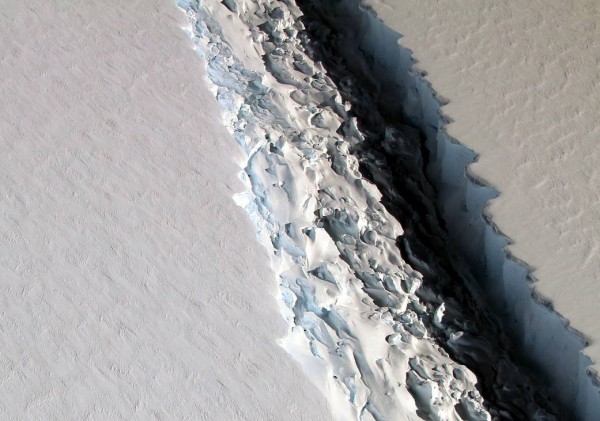By Ana Verayo, | December 05, 2016

On Nov. 10, 2016, scientists on NASA's IceBridge mission photographed an oblique view of a massive rift in the Antarctic Peninsula's Larsen C ice shelf. (NASA/John Sonntag)
A massive crack on the Antarctic ice shelf has opened up a new section estimated to be at 300 feet. The Larsen C Ice Shelf has been slowly deteriorating and breaking up. It will eventually break a massive chunk of iceberg the size of Delaware before it all collapses and disappears completely.
Like Us on Facebook
NASA IceBridge mission scientists conducted an aerial survey of this giant crack in the ice and estimated it to be 70 miles long. The crevice is around 300 feet wide and one-third of a mile deep.
Last Friday, NASA revealed a new image of the ice shelf taken on November 10 as the gigantic crack evolved into something longer, wider, and very deep. NASA scientists believe that this large section of ice will be broken off from the ice shelf indefinitely.
In more detail, NASA revealed that this crack completely cuts through the ice shelf. However not entirely across it, but once it does, this will produce an iceberg as large as the state of Delaware.
In 2002, the Larsen B ice shelf collapsed from the eastern side of the Antarctic Peninsula, as 1,235 square miles of solid ice broke apart into thousands of smaller icebergs in a period of 35 days. Scientists say that Larsen B has been in a stable condition for around 12,000 years. Its collapse was triggered by global warming. Past studies suggest that Larsen B began melting a few years before it totally disintegrated in 2002.
What remains of the Larsen B ice shelf is around 625 square miles, and there are looming fears about the future of the Antarctic Ice Shelf.
Some 386 square miles of ice has been lost in the past 40 years, located on the opposite side of the Antarctic Peninsula.
However, in the other regions of the Antarctic, the ice shelf has been increasing in volume, as satellite data reveals that the vast ice shelf apparently gained 112 billion tons of ice every year from 1992 to 2001. Between 2003 to 2008, it increased by 82 billion tons of ice every year on average.
-
Use of Coronavirus Pandemic Drones Raises Privacy Concerns: Drones Spread Fear, Local Officials Say

-
Coronavirus Hampers The Delivery Of Lockheed Martin F-35 Stealth Fighters For 2020

-
Instagram Speeds Up Plans to Add Account Memorialization Feature Due to COVID-19 Deaths

-
NASA: Perseverance Plans to Bring 'Mars Rock' to Earth in 2031

-
600 Dead And 3,000 In The Hospital as Iranians Believed Drinking High-Concentrations of Alcohol Can Cure The Coronavirus

-
600 Dead And 3,000 In The Hospital as Iranians Believed Drinking High-Concentrations of Alcohol Can Cure The Coronavirus

-
COVID-19: Doctors, Nurses Use Virtual Reality to Learn New Skills in Treating Coronavirus Patients







